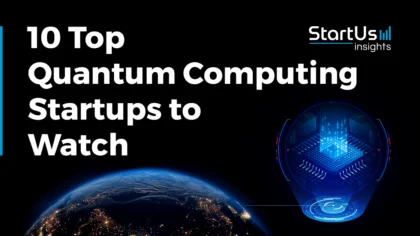Accelerate Productivity in 2025
Reignite Growth Despite the Global Slowdown
Virtual reality (VR) is transforming the way we experience and interact with digital worlds. For instance, cloud computing enables users to access complex VR applications using remote servers and high-speed internet. Volumetric VR allows users to capture and render 3D scenes and objects in real-time, making VR environments more realistic and interactive. 5G connectivity facilitates collaboration and multiplayer experiences with minimal latency. Further, haptics provides users with tactile feedback, such as touch, texture, and force, which enhances the sense of presence and immersion in VR. This research provides you with the top 10 VR trends ranging from high-fidelity display & audio and eye & gesture tracking to full body capture and interactive VR. Learn about the latest innovations and opportunities in the VR industry in this data-driven report.
Innovation Map outlines the Top 10 VR Trends & 20 Promising Startups
For this in-depth research on the Top Virtual Reality Industry Trends & Startups, we analyzed a sample of 3075 global startups & scaleups. This data-driven research provides innovation intelligence that helps you improve strategic decision-making by giving you an overview of emerging technologies in the VR industry. In the Virtual Reality Innovation Map, you get a comprehensive overview of the innovation trends & startups that impact your company.
These insights are derived by working with our Big Data & Artificial Intelligence-powered StartUs Insights Discovery Platform, covering 3 790 000+ startups & scaleups globally. As the world’s largest resource for data on emerging companies, the SaaS platform enables you to identify relevant technologies and industry trends quickly & exhaustively.
Tree Map reveals the Impact of the Top 10 Current Trends in Virtual Reality
Based on the Virtual Reality Innovation Map, the Tree Map below illustrates the impact of the Top 10 Virtual Reality Trends in 2024. Startups and scaleups are developing solutions for enhancing VR experiences and immersion. Cloud-based processing, the most prevalent trend, allows VR users to access high-quality content without expensive hardware. Volumetric VR and high-fidelity display & audio create realistic and immersive environments for various applications. 5G connectivity and VR streaming enable fast and seamless delivery of VR content across devices. Eye & gesture tracking and biometric feedback provide intuitive and natural ways of interacting with VR content and feedback. Full body capture records the user’s posture and motion and transfers it to a VR avatar. Lastly, haptics and interactive VR create immersive and dynamic experiences for users.
Top 10 Virtual Reality Trends (2024)
- Cloud-based Processing
- Volumetric VR
- High-Fidelity Display & Audio
- 5G Connectivity
- Eye & Gesture Tracking
- Haptics
- Interactive VR
- Full-Body Capture
- VR Streaming
- Biometric Feedback
Global Startup Heat Map covers 3075 VR Startups & Scaleups
The Global Startup Heat Map below highlights the global distribution of the 3075 exemplary startups & scaleups that we analyzed for this research. Created through the StartUs Insights Discovery Platform, the Heat Map reveals high startup activity in Western Europe, followed by the US and India. Below, you get to meet 20 out of these 3075 promising startups & scaleups as well as the solutions they develop. These virtual reality startups are hand-picked based on criteria such as founding year, location, funding raised, & more. Depending on your specific needs, your top picks might look entirely different.
Top 10 Virtual Reality Industry Trends in 2024
1. Cloud-based Processing
Immersive and interactive virtual reality applications now rely on cloud-based processing, offloading heavy computational tasks to the cloud. This allows VR users to enjoy high-quality graphics and audio without the need for expensive hardware. Cloud gaming platforms, such as Microsoft xCloud, are examples of cloud-based platforms delivering seamless VR experiences to gamers. Moreover, it facilitates collaborative VR experiences by allowing multiple users to interact and share the same virtual environment. This has significant benefits for professional use cases such as training, simulation, and collaboration. For instance, cloud VR allows remote workers to join virtual meetings, or trainees to practice skills in realistic scenarios. Several companies are further developing innovative solutions for cloud VR using technologies such as AI and advanced analytics.
LetsVR develops a Cloud-based VR Collaboration Platform
Romanian startup LetsVR builds a cloud-based platform that enables VR-powered collaboration for public and private entities. It provides software, hardware, and services to create immersive and interactive VR experiences for various use cases, such as training, education, and feedback. The startup leverages cloud computing to deliver high-quality VR content and data to multiple devices simultaneously, reducing costs and travel time. LetsVR’s solution enhances employee engagement, knowledge retention, performance, and safety.
XRStream enables VR Game Streaming from the Cloud
US-based startup XRStream provides cloud PC streaming for VR video games. It allows gamers to stream PC VR games from Steam using its app. For this, gamers use Meta’s Quest and Quest 2 headsets. The startup uses Google Cloud Platform (GCP) to host, render, and stream 3D and extended reality (XR) experiences. XRStream engages gamers in an immersive, interactive, and photorealistic experience without being tied to a physical computer.
2. Volumetric VR
Using volumetric VR, users explore 3D scenes that are realistic and engaging in virtual reality. Unlike traditional VR videos, volumetric VR captures videos with multiple cameras around the subjects, creating 3D models to view from any perspective. It is becoming a growing trend as it enables more interactivity and presence for the users. The use of volumetric VR videos in social media platforms also allows users to share their 3D selfies and stories with their friends and followers. Further, the integration of AI and ML in volumetric video processing enhances the quality and efficiency of the 3D models, reducing the bandwidth and storage requirements. VR manufacturers and app developers are leveraging photogrammetry, depth sensors, and light fields to build volumetric VR for education, entertainment, sports, and healthcare.
Iconic Engine creates Holometric Experiences
US-based startup Iconic Engine provides end-to-end solutions for creating and distributing immersive content. It offers a suite of products, including Holometric 4D Cinema, a turnkey system that enables location-based entertainment. The Holometric Chair is a 4D haptic motion chair that comes with built-in smart technology. Moreover, its Holometric Entertainment Platform (HEP) supports command and control of an entire fleet of theaters. Iconic Engine allows businesses to create metaverse experiences for their customers and streamline their management.
Volograms simplifies Volumetric Video Capture
Irish startup Volograms creates AI-powered 3D volumetric holograms of people from a 2D photo or video. It combines machine learning, computer vision, 3D reconstruction, and computer graphics. This way, the startup transforms 2D input into a realistic 3D representation for integration into immersive platforms. Further, it leverages AI algorithms for single-view volumetric 3D reconstruction, semantic human segmentation, deep texture synthesis, and motion capture. This accelerates 3D volumetric video production workflows. Moreover, it serves various industries such as fashion, games, tourism, virtual production, marketing, and more.
3. High-Fidelity Display & Audio
High-fidelity display and audio solutions create a realistic and immersive experience for the audience. They feature improved display resolution, wide field of view (FoV), spatial audio, and advanced optics. Improved display resolution reduces the screen-door effect and enhances the visual quality of the virtual environment. Whereas, wide FoV increases the sense of presence and reduces motion sickness. Further, spatial audio creates a 3D sound field that matches the virtual scene and head movements. And, advanced optics correct for distortion and chromatic aberration while enabling eye tracking and foveated rendering. Innovations in high-fidelity display and audio include microLED displays, light-field displays, holographic displays, binaural audio, waveguide optics, and varifocal lenses.
Hypervision offers Complete FoV Coverage
Israeli startup Hypervision develops optical, software, and hardware solutions for virtual and extended reality. It creates sunglasses-sized devices that offer a complete human field of view of 270 degrees to make VR/XR more comfortable, immersive, and realistic for users. The startup’s technology includes pancake lenses and foveated pass-through imaging. Its product, VR240.GEN2 has various applications, including driving/flight simulators, remote vehicle/robot operations, and immersive experiences. Hypervision also provides visual aid for people with vision impairment by augmented intensification of visual stimuli.
Treble Technologies builds Spatial Audio Technology
Icelandic startup Treble Technologies develops a cloud-powered acoustic simulation platform that enables the creation of virtual or real-life sound experiences. It utilizes wave-based sound simulation technology that allows virtual prototyping and synthetic audio generation with accuracy. The startup’s platform consists of four modules: acoustic simulation suite, synthetic data generation, API integration, and virtual sound engine. It has applications across industries such as architecture, gaming, automotive, and entertainment. Treble Technologies provide a seamless workflow for creating realistic and immersive sound environments that enhance user experience and satisfaction.
4. 5G Connectivity
In virtual reality, the integration of 5G connectivity enables low latency and high-speed data transfer. This allows for more immersive and realistic experiences as well as new possibilities for remote collaboration, education, and entertainment. The industry is exploring various technologies to leverage 5G connectivity for cloud rendering, edge computing, and network slicing. These technologies reduce the computational load on the devices, optimize bandwidth usage, and ensure the quality of service. By combining 5G connectivity and VR, businesses are creating innovative solutions to transform various industries and domains.
Pharrowtech enables Wireless Virtual Reality
Belgian startup Pharrowtech designs and develops millimeter wave (mmWave) hardware and software for next-generation wireless applications. It leverages 60GHz radio frequency (RF) technology to enable high-speed wireless broadband, wireless VR and augmented reality (AR) solutions. The startup’s products include PTR1060 (RFIC) and PTM1060 (RFM) and software solutions. Pharrowtech offers a low-cost, high-performance, and carrier-grade alternative to wired infrastructure, delivering gigabit-per-second speeds to consumers and businesses wirelessly.
Wilab offers an AI Framework for 5G Network
US-based startup Wilab provides a 5G NWDAF (Network Data Analytics Function) solution for mobile network operators. The startup’s platform enables network engineers to merge NWDAF capabilities with observability and ML frameworks for automating network operations. This enhances their ability to offer more immersive and engaging experiences for VR and gaming app users. Wilab helps operators improve network and customer experience assurance, scale and slice their networks efficiently, and migrate from 4G to 5G smoothly.
5. Eye & Gesture Tracking
To interact with virtual environments more naturally and immersively, VR applications are increasingly relying on eye and gesture tracking as essential components. By analyzing gaze-based interaction and saccade direction patterns, VR developers are creating more realistic and engaging experiences for users. Moreover, they study scene perception varying with tasks, and how people look around scenes in all directions. VR startups are leveraging technologies such as infrared cameras, machine learning algorithms, and wearable sensors to develop eye and gesture-tracking systems. These have applications in fields such as education, entertainment, healthcare, and social networking.
SeeTrue Technologies provides Advanced Eye-Tracking Systems
Finnish startup SeeTrue Technologies offers advanced eye-tracking solutions for various domains, such as medical, industrial, and AR/VR applications. It uses custom sensors and computer vision to achieve high accuracy and robustness in eye-tracking. The startup develops systems that use eye-tracking for both input and output, enabling accurate manipulation, user feedback, and anticipation of the next actions. The startup’s eye-tracking technology is compatible with head-mounted display (HMD) environments and different lighting conditions. SeeTrue Technologies also handles large user populations and diverse eye features in VR applications.
FANTM makes an Open-Source RCG Tracking Solution
US-based startup FANTM develops wearable human-computer interfaces (HCIs) for AR, VR, and more. It utilizes electromyography (EMG) technology to detect muscle signals and translate them into gestures and motions that control digital systems. Its product includes the FANTM DEVLPR Arduino shield, which allows users to easily connect their muscles to Arduino boards. This enables them to build and play games controlled by muscle flexion and integrate with robots for creative projects. FANTM provides intuitive, open-source, and low-cost hardware solutions for gesture and motion-based interaction in various domains, such as gaming, education, robotics, and healthcare.

6. Haptics
Haptics enhances the immersion and interaction of virtual reality systems. Such haptic devices enable users to touch and manipulate virtual objects with realistic feedback. For instance, there are different types of haptic devices for VR. This includes desktop, surface, wearable, and handheld haptic devices. Desktop haptics are fixed on a table or a platform and provide force feedback to the user’s hand or finger. Whereas, surface haptics create tactile sensations on a flat or curved surface, such as a touchscreen or a steering wheel. Further, wearable haptics are worn on the body, such as gloves, vests, or suits, and provide tactile feedback to various body parts. And, handheld haptic devices include controllers, pens, or smartphones, and provide vibration or force feedback to the palm or fingers. VR hardware manufacturers are leveraging motors, actuators, sensors, and ultrasound to develop innovative haptic devices and solutions for gaming, education, training, entertainment, and healthcare.
Dennisson Technologies builds an Artificial Muscle Platform
New Zealand-based startup Dennisson Technologies develops an artificial muscle platform for VR haptics and soft robotics. It uses AuraFlex, a thin and flexible actuator that contracts and expands like a real muscle. This actuator integrates into VR gloves, suits, and accessories to provide realistic haptic feedback for immersive VR experiences. Further, the startup offers custom solutions for soft robotics applications, such as prosthetics, medical devices, and wearable gadgets. Dennisson Technologies enables natural and intuitive movement sensations, enhancing people’s interaction with virtual and physical worlds.
Simulatory provides High-Fidelity Haptic Feedback
Swiss startup Simulatory uses virtual reality to create realistic surgical simulations. Using haptics and AI, it develops intelligent surgical systems that enable surgeons to train in realistic anatomy. The startup’s product, VRSpine, is a smart spinal endoscopy simulator. It simulates realistic spinal endoscopy with high-quality haptic feedback that matches the sensations of the procedure. Further, the hardware platform simulates the dilator, endoscopic camera, and rigid instruments like scissors, rongeurs, and electrodes. Simulatory enables surgeons to practice complex procedures in a safe and immersive environment, improving their skills and confidence.
7. Interactive VR
Interactive VR allows users to interact with the virtual environment and other users in real-time. This enhances the sense of presence and immersion that VR offers. The development of affordable and user-friendly VR headsets, controllers, and platforms also makes it more accessible to a wider audience. The audience enjoys interactive VR experiences on their smartphones, PCs, or standalone devices, without the need for expensive and complex hardware. Interactive VR is also used for various professional purposes like training, education, collaboration, and simulation. It provides a safe and effective way to learn new skills, practice scenarios, and communicate with colleagues. Moreover, this provides content creators to implement next-gen storytelling and immersive narratives that appeal to different emotions and preferences.
Market One Labs facilitates Metaverse Shopping
US-based startup Market One creates web3 solutions for e-commerce and retail brands. It enables them to build interactive VR stores that showcase and sell their digital, 3D products in the metaverse. Customers access these VR stores using headsets, web browsers, or mobile devices. Moreover, the startup provides a marketplace for artists to create custom stores for brands. Market One simulates real-life shopping scenarios and appeals to the emerging generation of digital natives.
Zoe Immersive builds a No-Code VR Creation Tool
US-based startup Zoe Immersive provides a no-code platform for creating and hosting interactive VR experiences. It consists of two main tools: the Zoe App and the Zoe SDK. Zoe App allows users to create and play VR experiences directly in their headset. It has built-in templates, demos, and programming tools. Zoe SDK enables users to build code-free immersive experiences in Unity, a popular game engine. The tools support real-time multiplayer collaboration, making it easy to share and co-create VR worlds with other developers. Zoe Immersive enables creators, educators, and learners to use immersive technologies that enhance their creative, communicative, and social abilities.
8. Full-Body Capture
With full-body capture systems, end-users and businesses are able to capture motion and performance without capital-intensive studio setups. They use sensors to track the movements and gestures of the entire body and synchronize the user’s body size with the digital twin’s or avatar’s proportions. Further, full-body capture solutions integrate with XR to create seamless and interactive virtual environments. This allows users to communicate and interact with each other in a natural and expressive way. Many startups are leveraging different methods, such as full-body scanning, 3D modeling, and AI-powered reconstruction to develop innovative full-body capture solutions.
Filmrare enables Digital Motion Capture
Indian startup Filmrare develops a virtual production studio platform that creates cinematic experiences for brands, filmmakers, and creative storytellers. It leverages tools like Unreal Engine, Unity Engine, pixel streaming, and digital motion capture to create immersive and realistic experiences. Moreover, digital motion capture allows the creation of realistic and engaging characters. It uses iPhone to capture the movements of real actors and apply them to the virtual world, bringing characters to life. Filmrare provides immersive and engaging virtual worlds that captivate and connect with the audience.
Marionette enables Suit-free Motion Recording & Editing
Danish startup Marionette provides suitless motion capture solutions for creators. They allow creators to record, edit, and export their own motion data to 3D characters using laptops and webcams. The startup also develops AI-driven software that extracts, cleans, and retargets motion in real-time, without the need for cloud upload or expensive suits. Further, it has applications in animation, gaming, VR/AR, education, and more. With Marionette, creators record their movements easily and quickly with minimal setup.
9. VR Streaming
VR streaming enables people to access and interact with VR content remotely, without requiring costly equipment or applications. It has various applications, such as VR gaming and eSports, where players compete and cooperate in virtual worlds. In virtual concerts and live events, fans take part in live performances and interact with their idols. Further, in VR training and education, learners acquire new skills and knowledge in realistic simulations. Advanced technologies such as cloud computing, 5G, and low-latency codecs enable VR streaming. Startups are offering VR streaming solutions for content creation, distribution, and monetization.
Eagle 3D Streaming offers Flexible 3D streaming
US-based startup Eagle 3D Streaming provides pixel streaming solutions for Unreal Engine applications. It allows users to access high-quality 3D content on any device through a web browser, without installing any software or plugins. The startup offers a self-serve pixel streaming platform, where users upload, manage, and stream their Unreal Engine apps. It also provides full-stack solutions to design, develop, and deploy web-based Unreal Engine experiences for various industries and use cases. Eagle 3D Streaming enables immersive and interactive 3D streaming experiences that are scalable, stable, and secure.
Condense Reality hosts Live 3D Video Streams
UK-based startup Condense Reality enables creators to stream live 3D video into virtual spaces. It combines computer vision, machine learning, and proprietary streaming technology to capture and broadcast real-world events like music and sports. This is done in any metaverse game or platform created with Unity or Unreal Engine. The startup creates immersive and authentic live experiences for a global audience without the need for VR headsets. Its product, Condense Live, helps music and sports rights holders generate more revenue from their content and attract new audiences. Condense Reality delivers immersive, live events to the world, collaborating with media, entertainment, sports, and education sectors.
10. Biometric Feedback
VR devices improve the user experience by using sensors to measure biometric feedback. This enables emotion detection and analysis, enhanced user authentication, and biometric-driven analytics. Emotion detection and analysis help VR applications to adapt to the user’s mood and preferences, creating more immersive and personalized scenarios. Enhanced user authentication improves the security and privacy of VR users by verifying their identity based on their biometric traits like fingerprints, iris, or voice. Further, biometric-driven analytics provide valuable insights into the user’s behavior, performance, and health, enabling VR applications to optimize their design and functionality. For these, startups are utilizing electroencephalography (EEG), electrocardiography (ECG), galvanic skin response (GSR), and eye tracking.
MI-VR aids DEI Training
US-based startup MI-VR provides immersive virtual reality training for diversity, equity, and inclusion (DEI). The startup partners with DEI experts and consultants to create scenario-based learning experiences. This helps participants understand how their bodies and mind react in different situations. The startup uses biometric feedback to measure participants’ physiological responses, such as heart rate and skin conductance, and teach them how to enhance their empathy and allyship. MI-VR helps people learn and practice positive behaviors in various situations, and make informed and ethical decisions in their personal and professional lives
iMVR builds Eye Tracking Tech
Canadian startup iMVR offers VR training for professional truck drivers. It develops IRIS, a VR simulator that uses eye-tracking technology, AI, and performance tracking to enhance road safety and driving skills. The platform allows drivers to practice in realistic scenarios, learn from their mistakes, and improve their communication and memory retention. It also provides compliance reporting and video replays for feedback and evaluation. iMVR’s VR training increases driver retention rates, reduces costs, and saves lives.
Discover all VR Trends, Technologies & Startups
Virtual reality future trends will further transcend entertainment and enable profound human-digital engagement. The VR landscape is evolving with novel modes of creation, such as VR locomotion and neural interfaces. Also, VR analytics provide reliable insights into audience behavior and engagement. Advances in immersive technology, 3D, and gamification will pave the way for dematerialization through rich sensory experiences. The VR Trends & Startups outlined in this report only scratch the surface of trends that we identified during our data-driven innovation & startup scouting process. Identifying new opportunities & emerging technologies to implement into your business goes a long way in gaining a competitive advantage
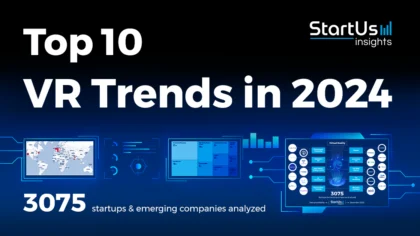
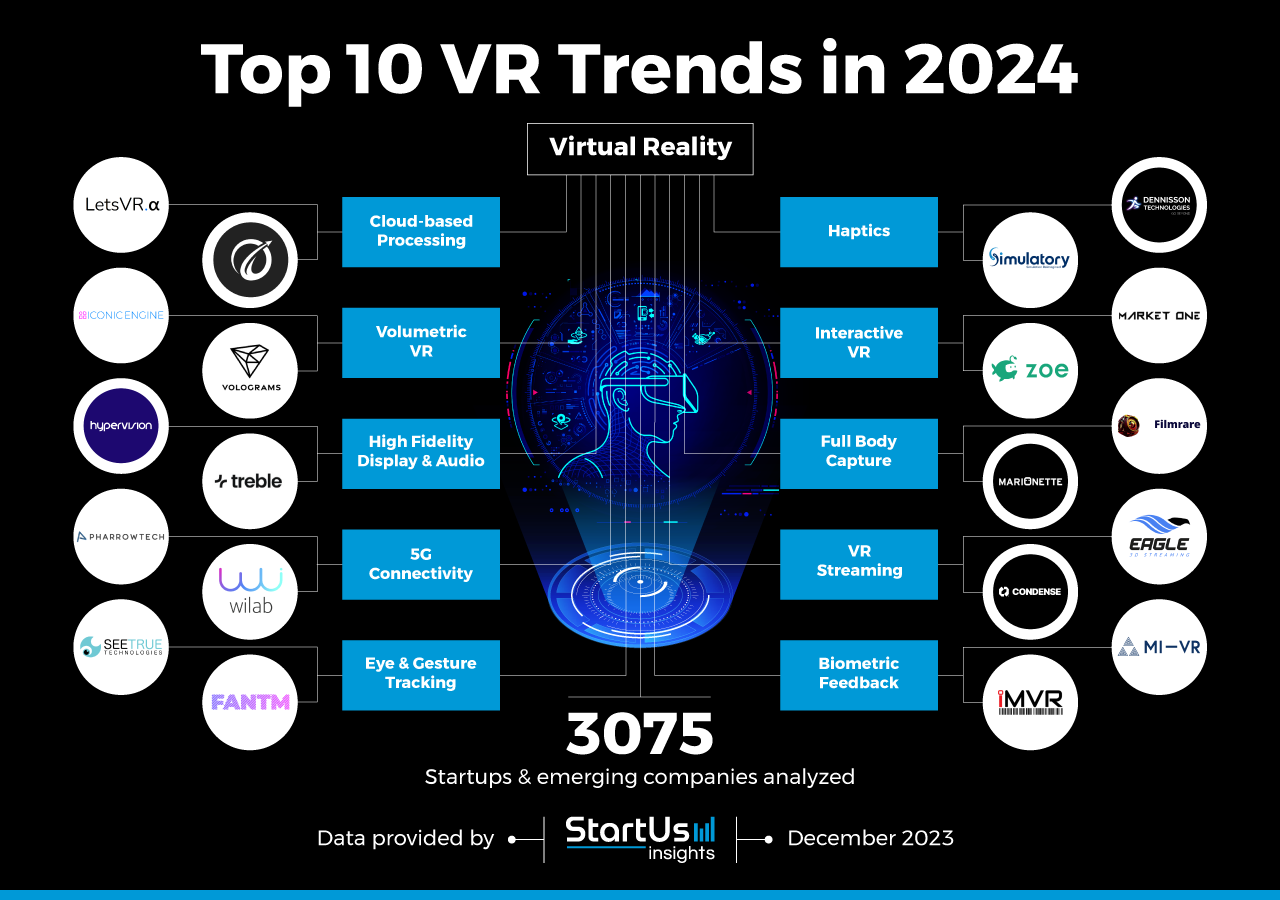
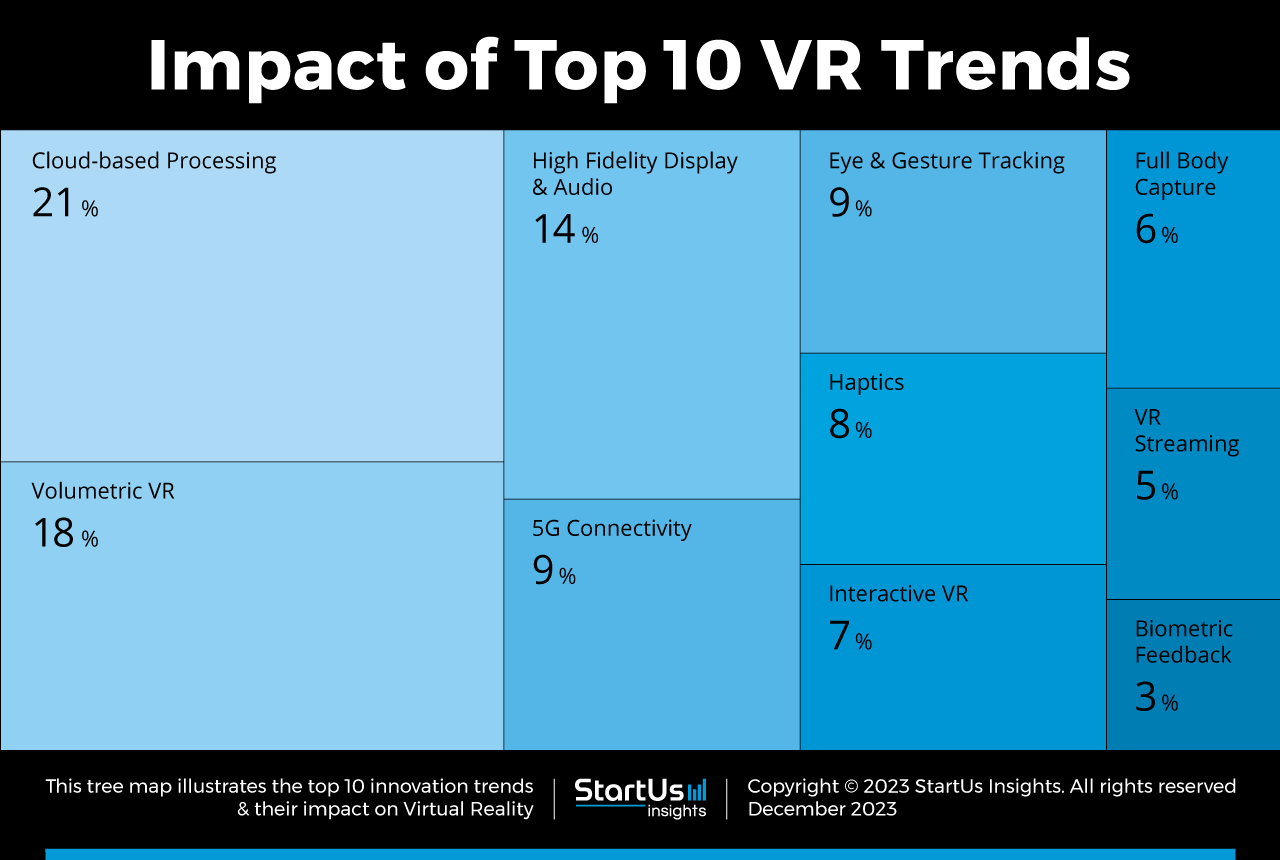
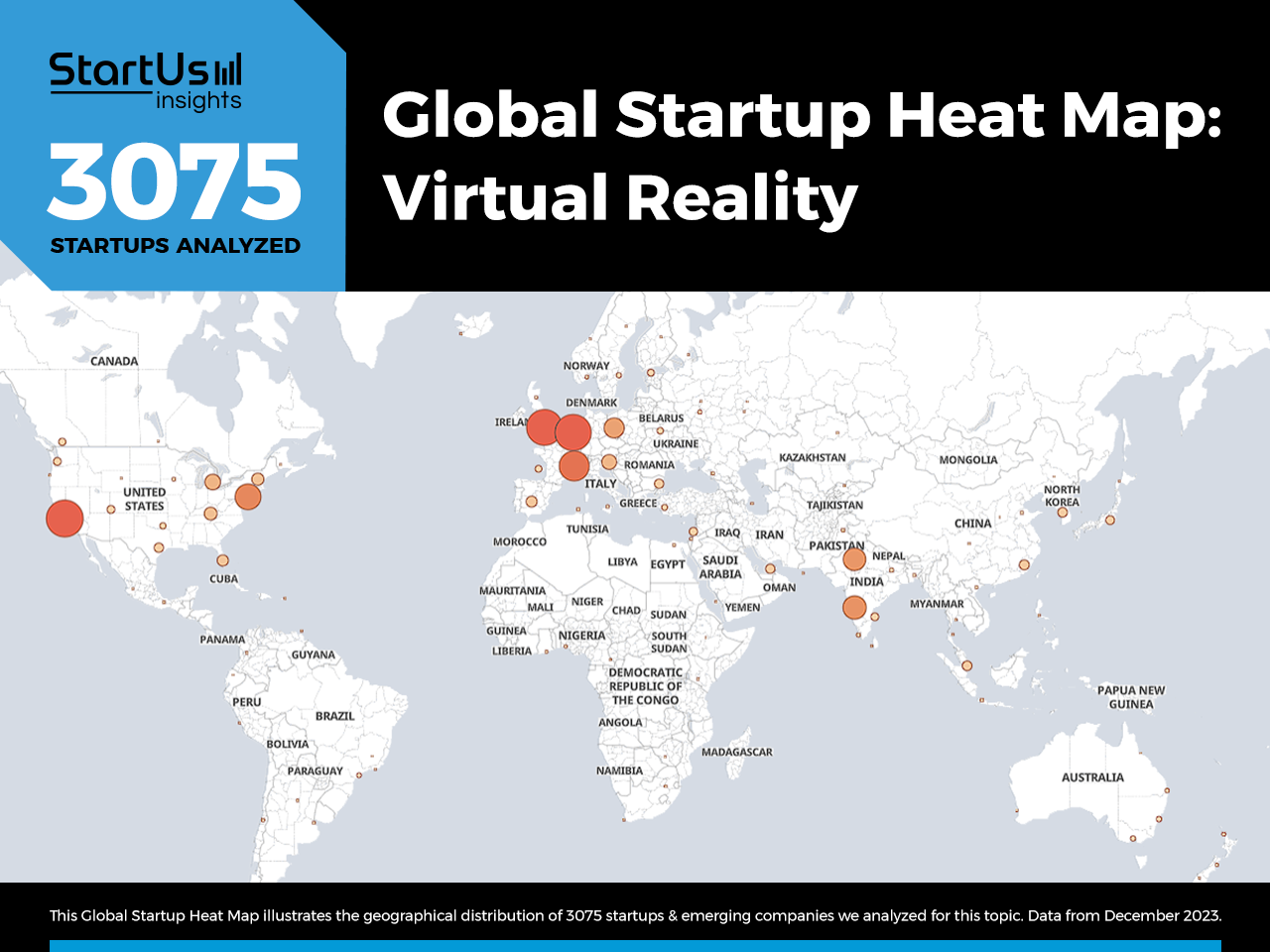
![Future of Robotics: 12 Trends Powering the Next Wave [2025-2030]](https://www.startus-insights.com/wp-content/uploads/2025/06/Future-of-Robotics-SharedImg-StartUs-Insights-noresize-420x236.webp)
